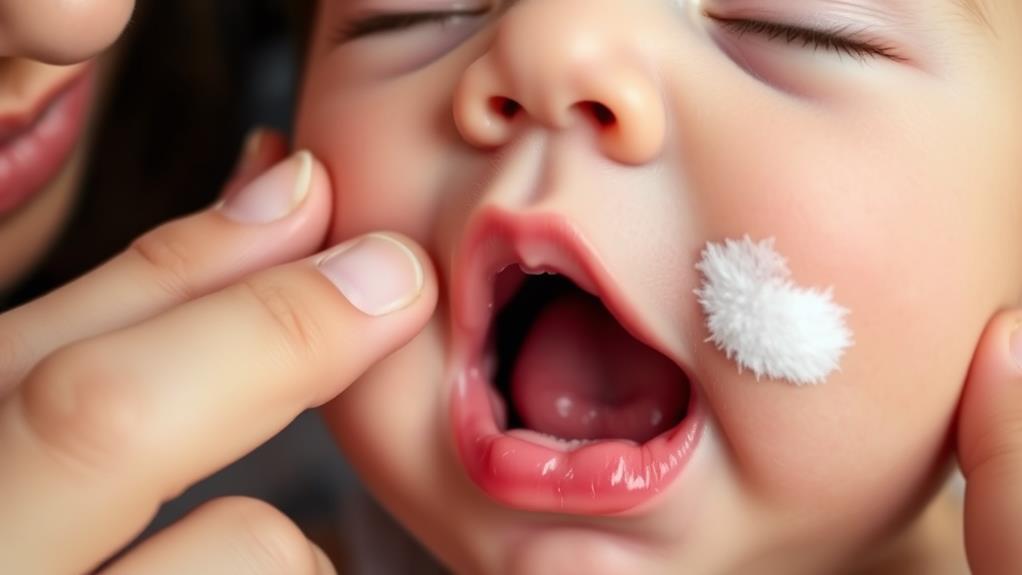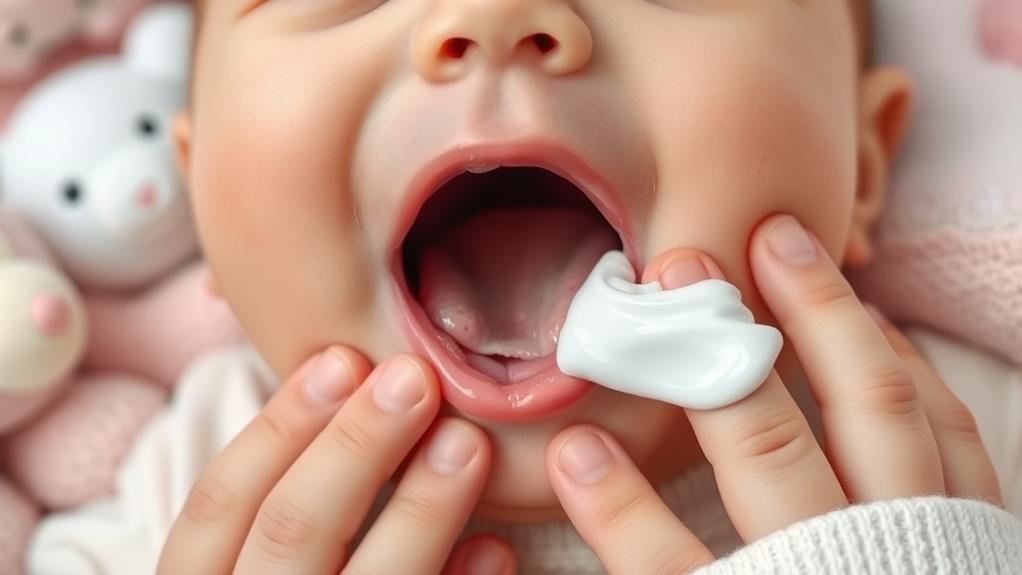If you've noticed white patches in your baby's mouth or signs of discomfort during feeding, you might be dealing with thrush, a common fungal infection. Understanding the causes, symptoms, and treatment options is essential for addressing this issue effectively. It's often linked to factors like antibiotic use or poor oral hygiene, but there are also preventive measures you can take. As you consider the best ways to manage this condition, you'll find that knowing more about early signs and effective treatments can make a significant difference in your baby's comfort and health.
What Is Thrush?

Thrush, which is an oral yeast infection primarily caused by the Candida fungus, can affect babies, leading to discomfort and feeding difficulties. It appears as white patches inside the mouth and on the tongue, often resembling cottage cheese.
You might notice your baby fussing more during feedings, as these patches can be painful. Thrush isn't just an inconvenience; it can affect your little one's ability to eat comfortably.
The infection can develop when the balance of yeast and bacteria in your baby's mouth gets disrupted. While it's not usually serious, it can be bothersome.
Thrush is more common in infants because their immune systems are still developing, which means they may not be able to fight off such infections as effectively as older children or adults.
If you suspect your baby has thrush, it's a good idea to consult a pediatrician. They can confirm the diagnosis and recommend treatment options.
Recognizing thrush early is essential, as timely intervention can help soothe your baby's discomfort and restore their feeding routine. Keeping the mouth clean and maintaining good hygiene can also help prevent future occurrences.
Common Causes of Thrush
Several factors can contribute to the development of thrush in babies. One of the main causes is an overgrowth of the Candida fungus, which normally lives in your baby's mouth, digestive tract, and skin without causing harm. When their immune system is weak or their body experiences an imbalance, this fungus can multiply and lead to thrush.
Another common cause is antibiotic use. If your baby takes antibiotics, these medications can disrupt the natural balance of bacteria in their body, allowing the Candida fungus to thrive.
Additionally, if you're breastfeeding, your baby might develop thrush if you have a yeast infection on your nipples, as this can transfer the fungus during feeding.
Certain medical conditions, such as diabetes or immunodeficiency disorders, can also increase the risk of thrush. Babies with these conditions may struggle to fight off infections, making them more susceptible.
Lastly, poor oral hygiene or prolonged use of pacifiers can create a warm, moist environment in your baby's mouth, promoting fungal growth.
Understanding these causes can help you take steps to prevent thrush and keep your little one healthy.
Recognizing Symptoms

Recognizing the symptoms of thrush in your baby is important for timely intervention. Thrush can present itself in a few distinct ways, and knowing what to look for can help you take action sooner. One of the most common signs is the appearance of white patches in your baby's mouth. These patches can look like milk curds but won't wipe away easily, and they may appear on the tongue, gums, or inner cheeks.
Another symptom to watch for is discomfort during feeding. If your baby seems fussy or refuses to eat, it could be a sign that they're experiencing pain from the thrush. You might also notice signs of diaper rash, which can occur due to the yeast spreading. In some cases, thrush can cause a red or irritated rash in the diaper area.
Keep an eye on your baby's mood and feeding habits. If you see any of these symptoms, it's best to consult your pediatrician. Early detection and treatment can help relieve your baby's discomfort and prevent the infection from worsening.
Stay vigilant, and trust your instincts; your baby's health is always worth a closer look!
Risk Factors for Babies
While many babies can develop thrush, certain risk factors increase the likelihood of infection. One major factor is age—infants, especially those under six months, are more susceptible because their immune systems are still developing.
If your baby was born prematurely, they may also face a higher risk due to an even less mature immune system.
Another critical risk factor is antibiotic use. If your baby has been given antibiotics, these medications can disrupt the natural balance of bacteria in their mouth, allowing yeast to flourish.
Similarly, if you're breastfeeding and taking antibiotics, the medication can pass into your milk, affecting your baby.
Babies who wear pacifiers or have a history of oral thrush are also at a greater risk. If a pacifier isn't cleaned properly, it can harbor yeast, which can then be transferred to your baby's mouth.
Lastly, if your baby has a weakened immune system due to a medical condition, they may be more prone to infections like thrush.
Keeping these risk factors in mind can help you take steps to minimize your baby's chances of developing thrush.
Diagnosing Thrush

Diagnosing thrush in babies typically involves a straightforward process that starts with a physical examination.
When you take your baby to the pediatrician, they'll look inside your little one's mouth for white patches on the tongue, gums, and inner cheeks. These patches are usually the first sign of thrush, which is caused by an overgrowth of Candida fungus.
Your doctor might ask questions about your baby's feeding habits, as thrush can sometimes appear after breastfeeding or bottle feeding. They'll also check for any signs of discomfort or fussiness, as thrush can make feeding painful for your baby.
In some cases, the doctor may take a swab of the affected area to confirm the diagnosis. This test is quick and helps ensure that what your baby has is indeed thrush, not another condition.
If you suspect your baby has thrush, it's essential to consult with a healthcare professional. Early diagnosis can lead to a more straightforward resolution, ensuring your baby stays comfortable and happy.
Treatment Options Available
Once your baby's thrush is diagnosed, it's important to explore the treatment options available to alleviate the condition. The most common treatment involves antifungal medications, which can effectively clear up the infection. Your pediatrician may prescribe an oral medication like nystatin or fluconazole. These are usually easy to administer and can help your baby feel better quickly.
In addition to medication, maintaining good oral hygiene is crucial. Gently wiping your baby's mouth with a soft, damp cloth can help remove some of the yeast buildup.
If you're breastfeeding, it's vital to treat any potential infection on your nipples as well. Your doctor might recommend an antifungal cream for this purpose.
It's also essential to follow the prescribed treatment consistently, even if your baby seems to improve. Stopping early can allow the thrush to return.
Keep in touch with your pediatrician throughout the treatment process, and don't hesitate to reach out if you have questions or concerns. By staying informed and proactive, you'll help ensure your baby recovers swiftly from thrush and feels comfortable again.
Home Remedies and Care

Many parents look for effective home remedies and care strategies to complement medical treatments for thrush in babies. One simple approach is to maintain good oral hygiene. Gently wiping your baby's mouth with a clean, damp cloth can help remove excess yeast.
You might also consider using a mixture of water and baking soda to rinse your baby's mouth, as the baking soda can create an unfavorable environment for yeast.
Another option is to incorporate probiotics into your baby's diet, which can help restore the natural balance of bacteria. If you're breastfeeding, you can eat yogurt with live cultures, as this may pass beneficial bacteria to your baby through your milk.
Additionally, ensure your baby's pacifiers and bottles are regularly cleaned and sterilized, as this can help minimize yeast growth.
Lastly, keep an eye on your baby's diet, especially if they're eating solid foods. Reducing sugary foods can help, as sugar can feed yeast.
Preventing Thrush Recurrence
To keep thrush from coming back, it's important to adopt a few preventive measures alongside home remedies. First, you should maintain good hygiene. Make sure to wash your hands thoroughly before handling your baby, especially before feeding or changing diapers. This simple step can help minimize the risk of fungal infections.
Next, regularly clean any items that come into contact with your baby's mouth, like pacifiers and bottles. Boiling these items or using a dishwasher can effectively kill any lingering yeast.
If your baby is breastfeeding, make sure to check your own nipples for any signs of thrush, as it can easily pass back and forth between you and your little one.
Additionally, keep your baby's environment dry and well-ventilated. Yeast thrives in damp areas, so change wet diapers promptly and allow your baby's skin to breathe.
If you're using antibiotics for any reason, talk to your doctor about taking probiotics, which can help restore a healthy balance of bacteria.
Lastly, be mindful of your baby's diet as they grow. Introducing a balanced diet can help their immune system stay strong, making it less likely for thrush to return.
When to Consult a Doctor

If you notice persistent symptoms of thrush in your baby, it's crucial to consult a doctor promptly. Thrush can lead to discomfort and might affect your baby's feeding habits, so addressing it quickly is essential.
If your baby seems fussy, has difficulty feeding, or refuses to eat, these could be signs of thrush that need attention. Additionally, if you see white patches in your baby's mouth that don't wipe away easily, or if they're showing signs of pain while feeding, don't hesitate to reach out to a healthcare professional.
It's also important to consult a doctor if the thrush symptoms last longer than a couple of weeks or if they seem to get worse despite any treatments you've tried at home.
In some cases, thrush can be a sign of an underlying issue, especially if your baby is under three months old. Trust your instincts as a parent; if something feels off, it's always best to get a second opinion.
Your baby's health is a priority, and getting the right care can help ensure they feel better soon. So, don't wait—reach out to your doctor if you have concerns!




